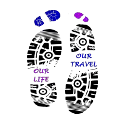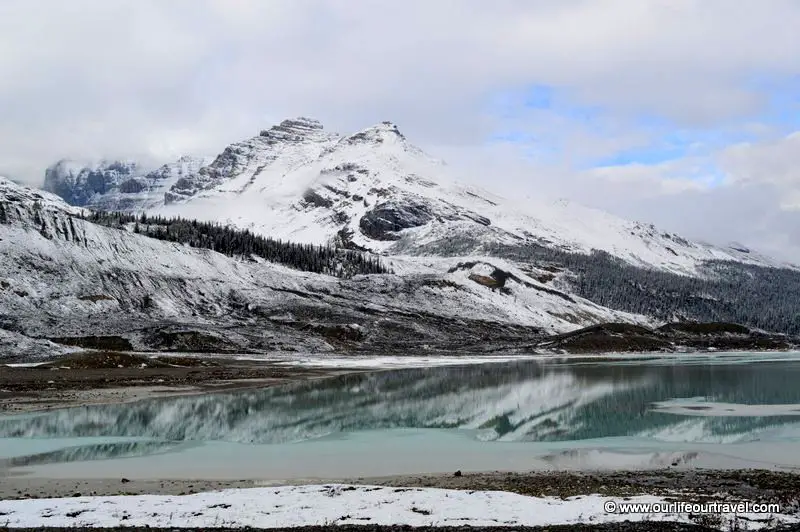After spending our weekends hiking around Vancouver, finally, we had a bit more free time, so it was time for new mountains!
We wanted to go hiking, but as I was carrying our first child in my belly, we didn’t want to overdo it, so going on a road trip to the Canadian Rockies seemed like the perfect choice. It was a warm-up before hopping on a plane to Las Vegas and visiting the Death Valley and the Grand Canyon.
The Canadian Rocky Mountains are about 900 km from Vancouver, so getting there and back can be a fun road trip. While being in the mountains, you can hike to different peaks or lakes every day. One option to get there is by train, but we rented a car for our trip to be flexible with transportation as our free time was limited.
Let us show you our Canadian Rockies Road trip itinerary.
Canadian Rockies Road Trip From Vancouver
Canadian Rockies Road Trip Map
This map shows our itinerary from Vancouver to Banff and Jasper.
How to get to the Rockies?
By car
Although we drove from BC, you can easily make a very similar Canadian Rockies Road trip from Calgary (Day 5 and onwards), and you will even save a LOT of hours on driving. Vancouver was crazy far.
By plane & car
The rest of Canada is even further. If you explored Montreal or Toronto and still have a couple of days extra, and you love the mountains as much as we do, you can fit a Rockies trip into your itinerary. We would recommend you to take a plane first and then hire a car closer to the Rockies to maximize your experience and avoid extensive driving.
Travel Resources
There is nothing better than a relaxed holiday. To ensure your rest, make sure you reserve and book your accommodation and transportation in advance of your trip.
- Book a small group of private tours with us at amazinglapland.com to make your experience magical in Lapland.
- Don’t forget to insure yourself during your travels: SafetyWing. Check out their policies HERE. It also covers several virus-related expenses.
- Look for the best prices on flight tickets, hotels, and car rentals: Expedia
- Car rental: SIXt
- Accommodation: Booking.com, Agoda or Hostelworld if you travel on a budget. Don’t forget that you can search for Apartments also on Booking.
- Activities: GetYourGuide
- Opinions on hotels and restaurants: TripAdvisor
- Was your flight canceled or delayed? Get up to 600€ back with the help of Compansair!
Day 1. Vancouver – Kamloops (430 km driving)
We didn’t drive from Vancouver to Kamloops the shortest way, but definitely on one of the most spectacular, on the Trans Canada Highway. It is one of the world’s longest highway systems with its 8000+ km length across Canada. We drove on the part of it from Vancouver, but it starts on Vancouver island already. When I write a highway, I must note that I don’t picture two multi-lane roads separated by hedges from each other. In Europe, you would simply call this Canadian highway a national road or something like that, but not a highway. It’s only specialty the white-on-green, maple-leaf route markers sign. Every highway has its own boards that depict the symbol of the road that can be animal or plant (at least so far, we’ve seen only such symbols).
The highway leads through the southern part of Fraser Canyon. It gets dryer and dryer as you go more north and have a higher altitude. The granite walls look great, especially if you like railways. The railway tracks run on both sides of the canyon, and you can observe extra-long trains. The shortest one I’ve seen had only 150 railway wagons (and three locomotives), which means the trains are easily 2.5-3 km long.
If you are not that much fun of the railway, you can just have a stop at Hell’s Gate, where the canyon has very steep walls, and according to my colleagues, it is one of the best spots to watch salmon migrating back to the rivers as it is very narrow.
After Cache Creek, the road turns to Thompson Valley. Another, very, very dry valley with the long Kamloops Lake. If the rain is not pouring and you reach this part in brightness, you can enjoy the views for sure.
Check out the accommodation prices in Kamloops!
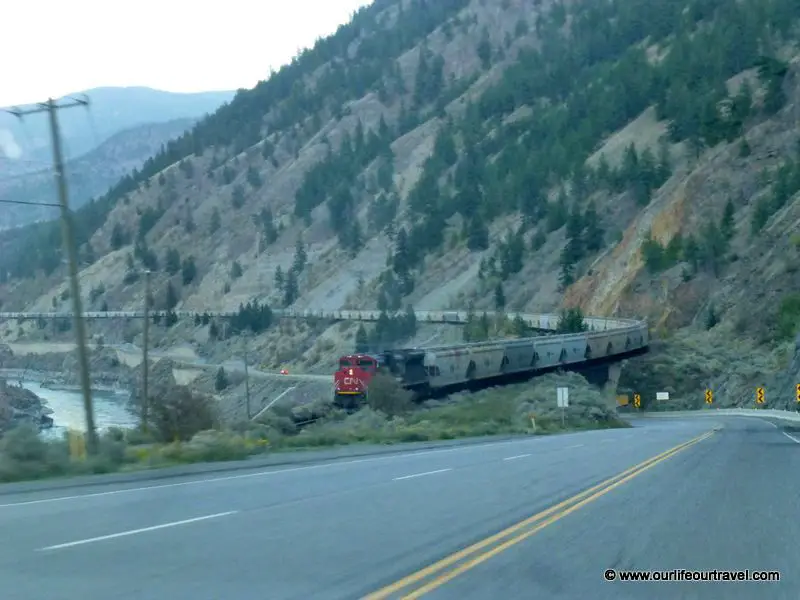
Day 2. Kamloops – Golden (360 km driving) and hiking to the Cinnamon Ridge
After spending the night at a roadside motel, we woke up to sunny weather. By the way, the motel was nothing like in the movies. First, I was afraid that it would be very crappy, with all the bad horror movies’ assets as they even looked like that from outside, but it was a positive surprise. Everything was neat and beautiful. Better motels have a pool and hot tub as well. The room was also well equipped with a fridge, microwave oven, and coffee machine. I was so surprised that I forgot to take pictures of all the motels inside 😀
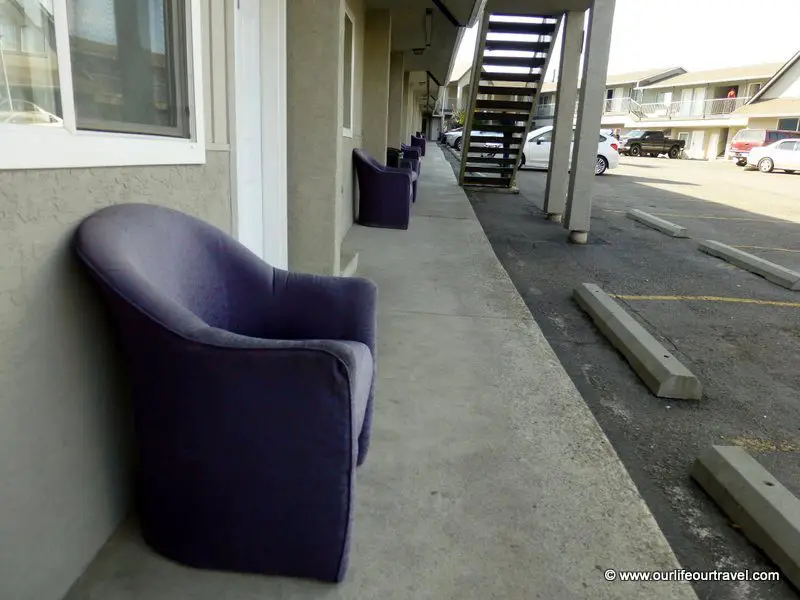
| HIKE: Cinnamon ridge |
|---|
| Distance: 7 km |
| Elevation Gain: 200 m |
| Number of people we met: 8 |
[sgpx gpx=”/wp-content/uploads/gpx/kamloops.gpx”]
We have visited Cinnamon Ridge, where we planned a short hike. It became a bit longer when Katalin did some unsuccessful shortcuts, and now we also know why not touch a cactus. Ever. And definitely, don’t grab it. Even after many days, it gives you unpleasant aches if you did not (or could not) remove all the needles. Besides the extraordinary adventures, the place is a charming, badland-like, spectacular view of the extra-long trains.
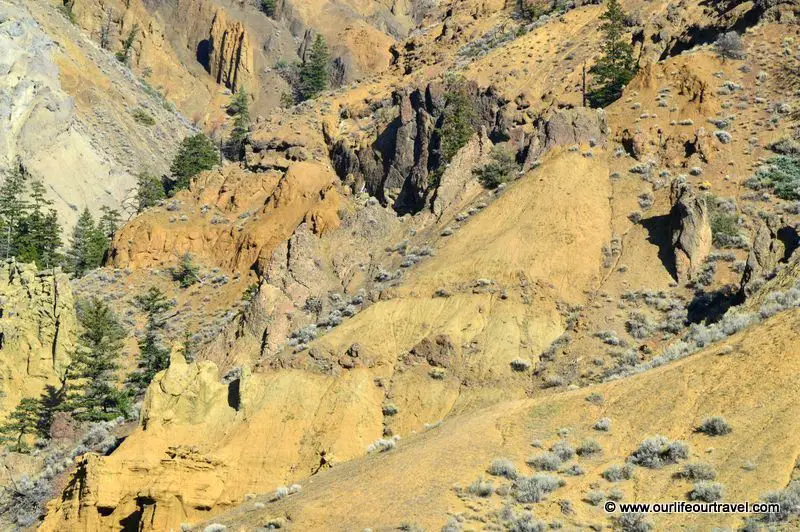
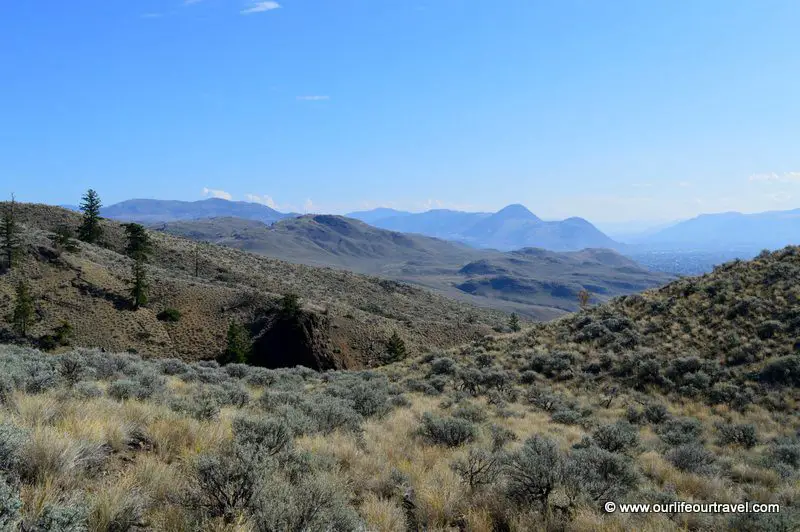
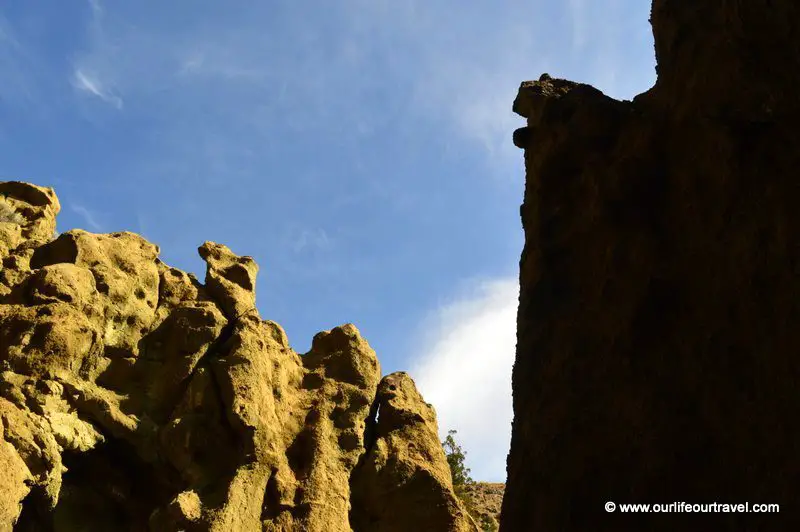
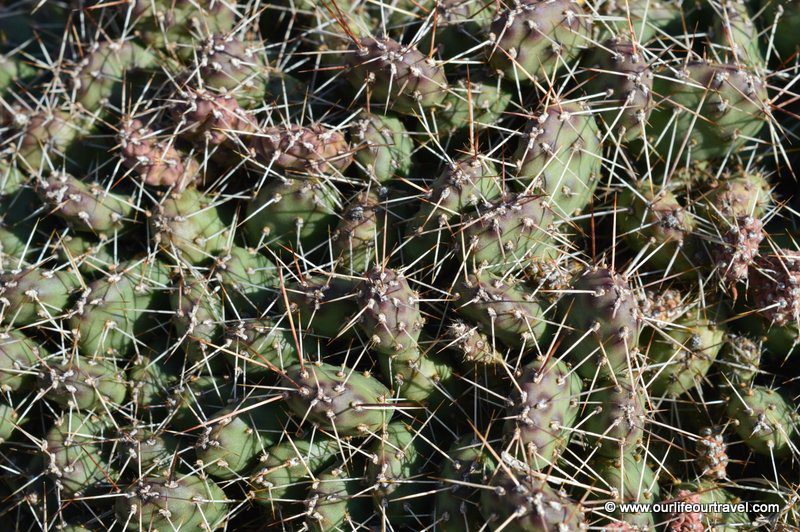
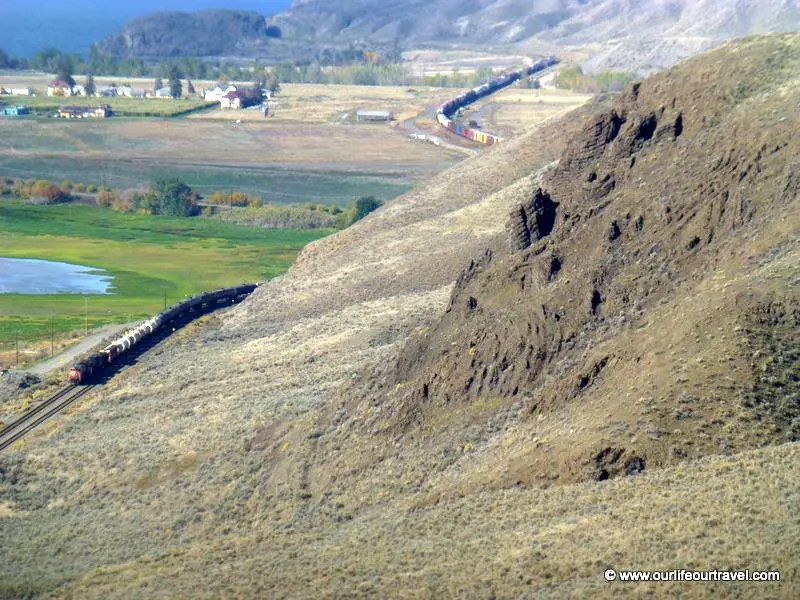
Day 3. Golden and hiking in the Glacier National Park
The Glacier National Park is part of the Selkirk Mountains (Columbia Mountains). The trailhead at Illecillewaet Campground has many information boards about the railway, the railway building history, and artifacts. The national park became a famous elite holiday place when the railway had a luxury stop, a hotel with every kind of service there. The mountains, the glaciers, nature were a perfect getaway from the cities for the rich.
Nowadays, it is only a hiking destination, the railway runs in a tunnel under the mountains, and the once upon a time famous Glacier House had been closed a long time ago. Since the railway went through a tunnel under the bridges, fewer guests were visiting the place. However, it was necessary to build the tunnel, as the avalanches often blocked or even destroyed the tracks. And not only the railway traffic had problems with the snow. This section of the highway has the most avalanches in the whole of Canada.
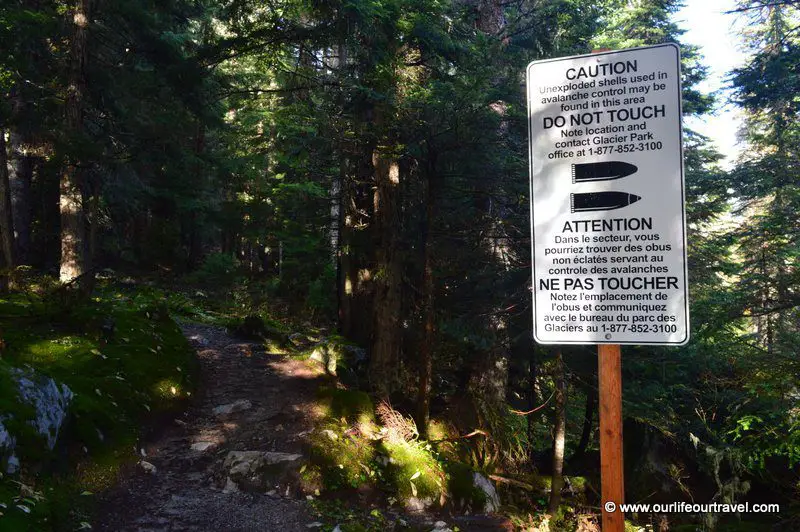
| Abbott Ridge Hike |
|---|
| Distance: 14 km |
| Elevation Gain: 1100 m |
| Number of people we met: 4 |
[sgpx gpx=”/wp-content/uploads/gpx/abbottridge.gpx”]
The weather was cloudy, but we still decided to climb to the Abbott Ridge (2274 m a.s. l). In the first part of the hike, the mountains and glaciers were hiding and sometimes showing themselves for a short moment between the clouds. Fog, clouds, and snow were everywhere. I enjoyed the winter scenery. Later the sky cleared up a bit, and we had a view over almost the whole park from Abbott Ridge. On the way down, we had a bit of sunshine, which melted most of the snow from the trees and the ground. On the trail, we met with four other people. A perfect day in nature!
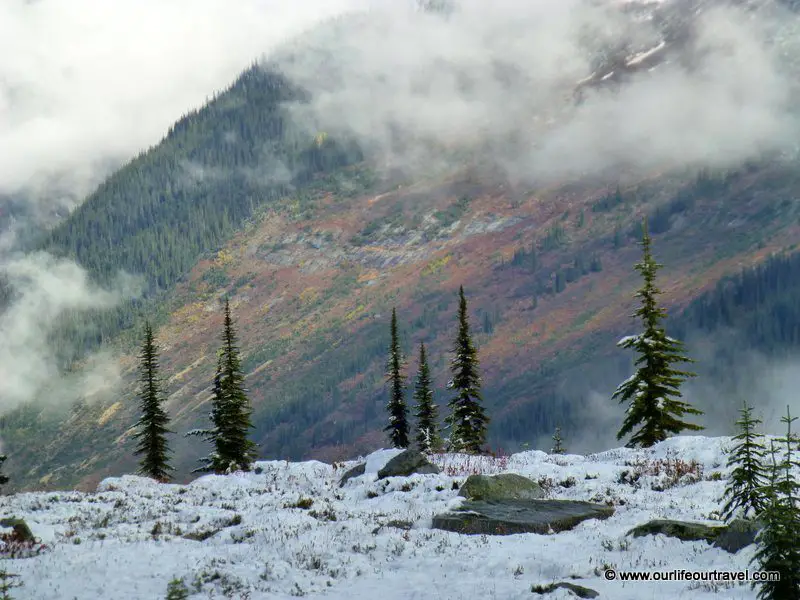
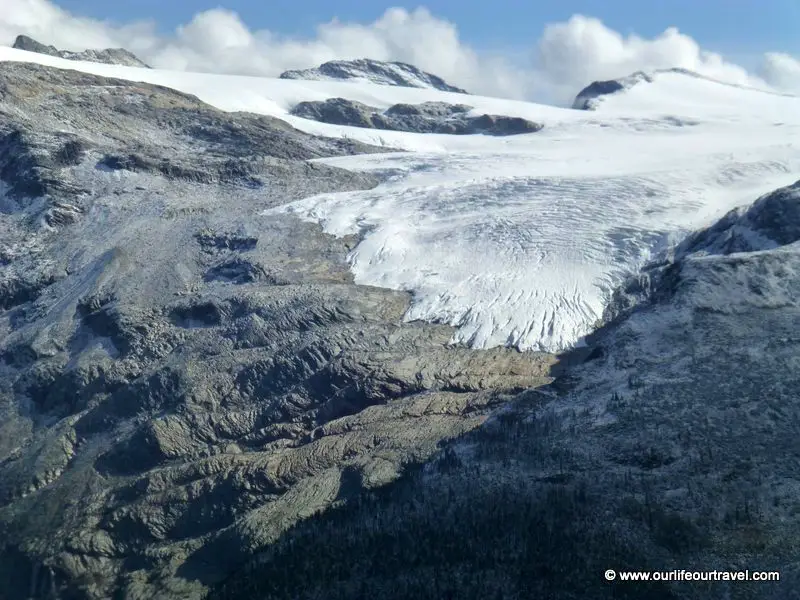
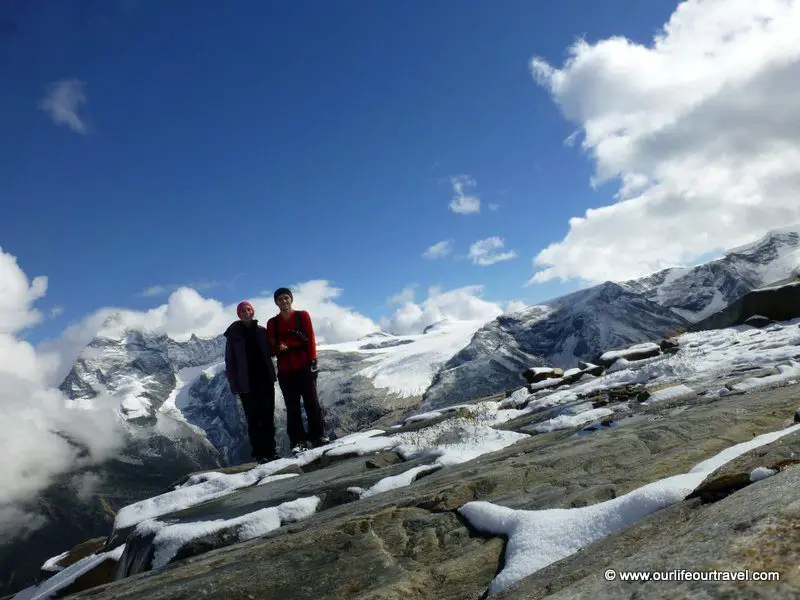
We drove back to Golden, to a small town with significant railway traffic. The motel we stayed in had a hot tub, similar to the one in Kamloops, and this time we even tried it. We arrived hungrily, and we didn’t want to go outside of our warm room. Luckily, we managed to order pizza online, without any working phone number, to enjoy the rest of the evening in the room.
Book your place in Golden now!
Day 4. Golden – Radium Hot Springs – Banff (240 km driving with stops)
We left Golden in the morning and had a short spa visit at Radium Hot Springs, at the Rocky Mountains’ edge. Finally, we started our road trip in the Rockies! The hot spring is not as good as the ones in Hungary. There is a typical swimming pool with slightly warm water, a heated pool, and a hot tub. The pools are real pools, the only advantage for them that they are outside, and you can see the rocks from them. Considering that it was a cloudy October Monday, many people were soaking themselves, and even more came later when we left.
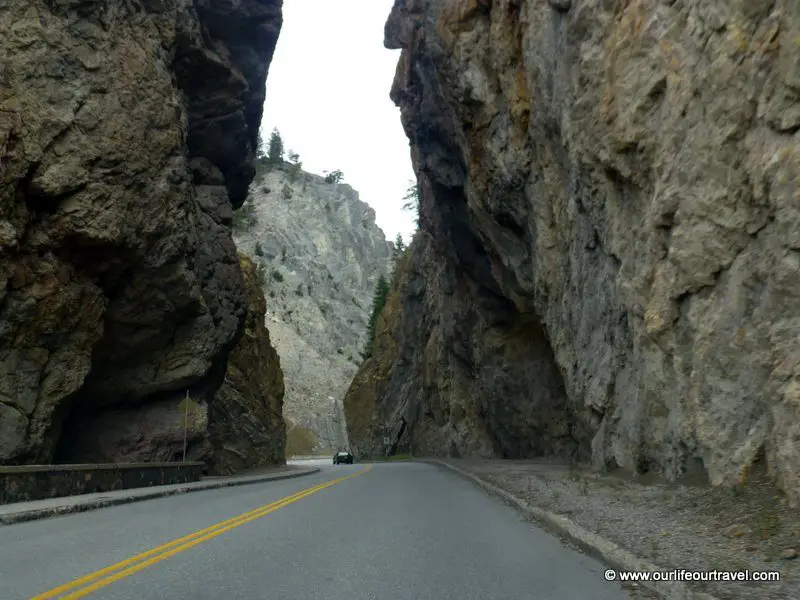
After a short dip, we continued our way to Kootenay National Park through Sinclair Canyon. We took quick photo stops here and there and had short walks. Rivers, glaciers, mountains. The only cultural stop we made was at ’Paint Pots’ to check the ochre beds. Already the Indians (called First Nations in Canada) used them as body paint, and during the last centuries, ochre was collected from this area. Nowadays, you can still see the old pools where the iron-rich water flew, the beds they made from the mud to get the coloring, and some machinery as well. The mining was banned totally when the national park was established. Near to this heritage, there is the Marble Canyon, but don’t be mistaken. Not a real canyon, and we haven’t seen any marble either.
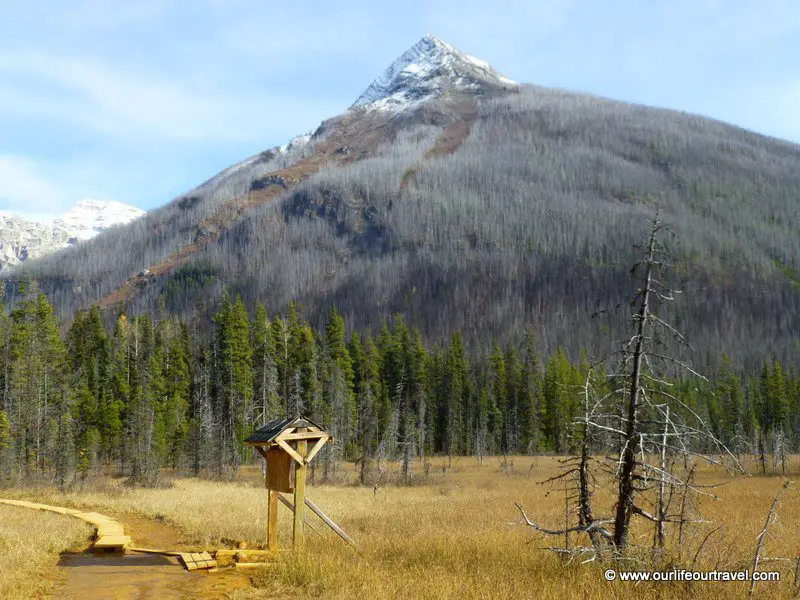
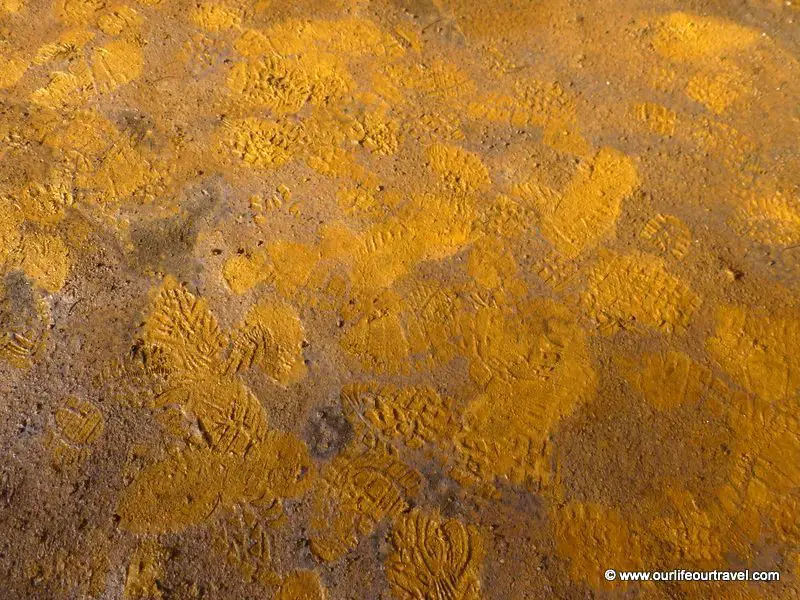
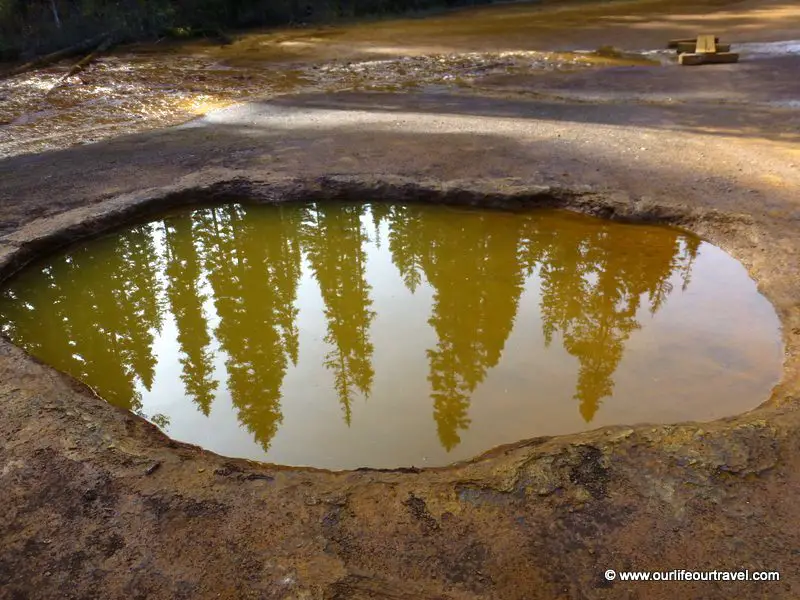
What else can you notice immediately in Kootenay? The remains of the forest fires. There was a massive outbreak in 2003, and 17 000 ha forests burned. Nowadays, you can see the burned, fallen, or still standing charred trees. Among them, the new seedlings are growing and making the area green again. The forest is returning. The Marble Canyon trail was meant to show the results of the fires.
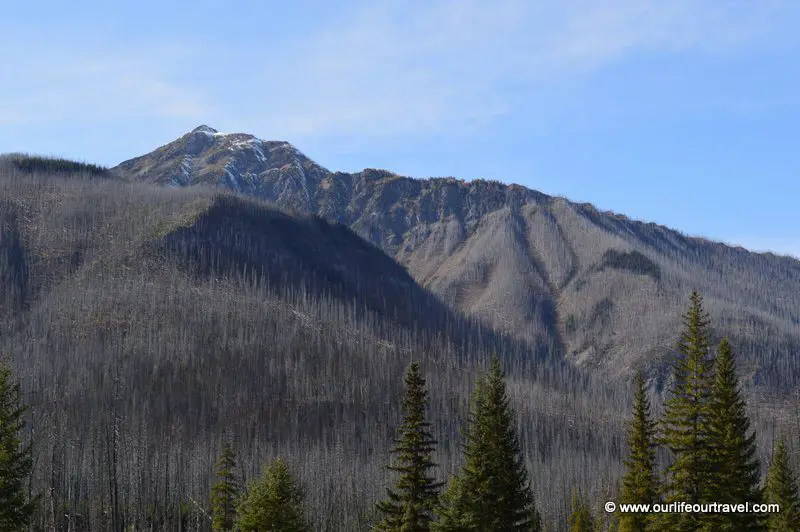
After leaving Kootenay National Park, we entered Banff National Park. As the weather became perfect, we had a few more photo stops before checking in to our hostel in Banff.
Day 5. Banff – Bow Lake – Banff (180 km) and hiking to Dolomite Pass
Our accommodation for the next five nights was in Banff. The hostel was pretty cool: a well-equipped kitchen, laundry place, and social hangout place beside the dorm rooms. There could have been more toilets, but that was my only concern.
Check out the hostel we stayed in.
Banff is like Zakopane of Tatra. The only difference is that high mountains surround it in every direction. The similarities are that every local live from tourism, the city is full of souvenir shops, hotels, inns, restaurants, and tour operators. Luckily we were not in high season so that it could be tolerable. It also means that the weather was unpredictable. One day it was +10°C and sunny, another day freezing and snowing.
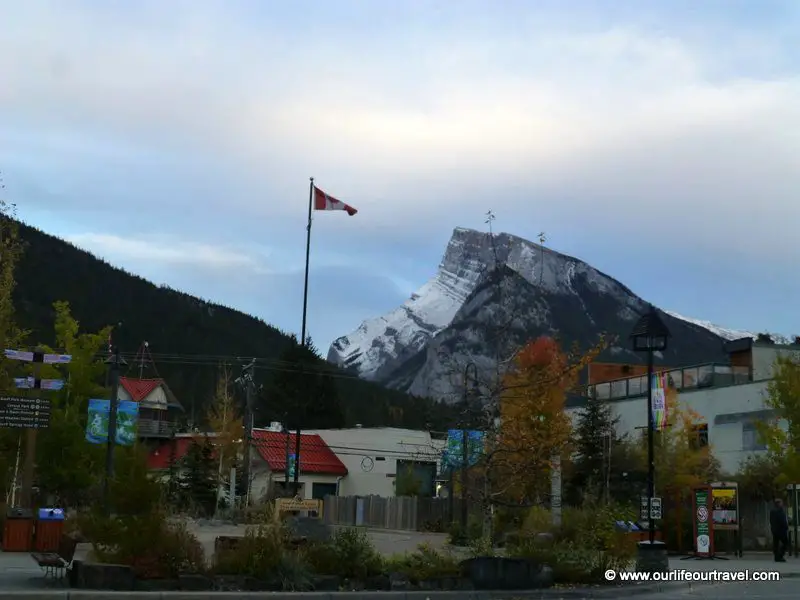
We decided to stay so long in Banff as it is easy to reach every trail we wanted to hike from there, and there are not many other options in the Rocky Mountains. Most of the accommodation places were in Banff and Jasper, and there are no budget options elsewhere.
| Dolomite Pass |
|---|
| Distance: 14.6 km |
| Elevation Gain: 600 m |
| Total Time: 5 hours |
| Number of people we met: 6 |
[sgpx gpx=”/wp-content/uploads/gpx/dolomitepass.gpx”]
The first hike we did lead to the Dolomite Pass (14.6 km Distance, 5 hours). We aimed at Cirque Peak beforehand, but due to the snow clouds and low visibility, we changed our route from Helen Lake. The hike is quite easy, but it was very muddy. After the lake, it became very wet as well for a short distance.
When we reached the Dolomite Pass, it started to snow more. The views were pretty spectacular, but for me, the best part of the hike was to see probably spruce grouse/trail chickens (Falcipennis Canadensis) from very close. One of them was just enjoying the snow next to my feet. First, I was afraid that it would fly away that didn’t seem to be bothered by us, so we took millions of shots of it. On our way back, we have seen even more of them around the same spot.
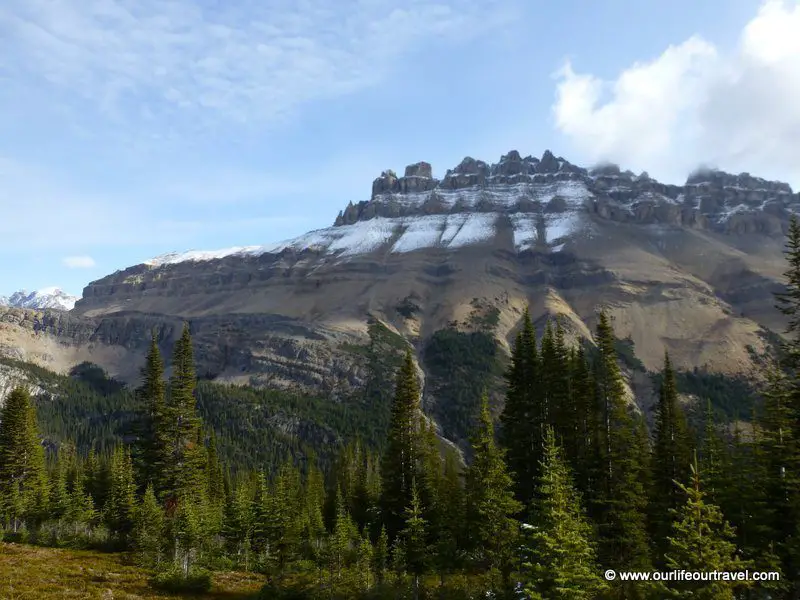
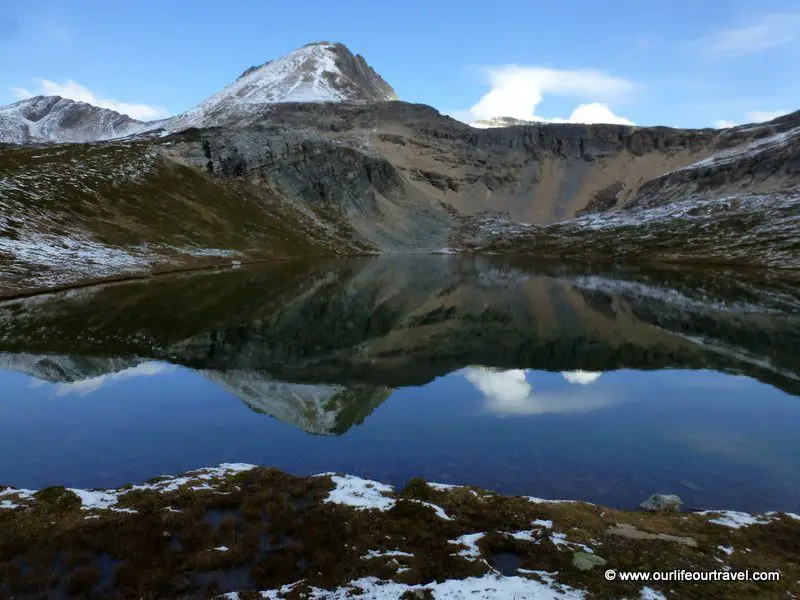
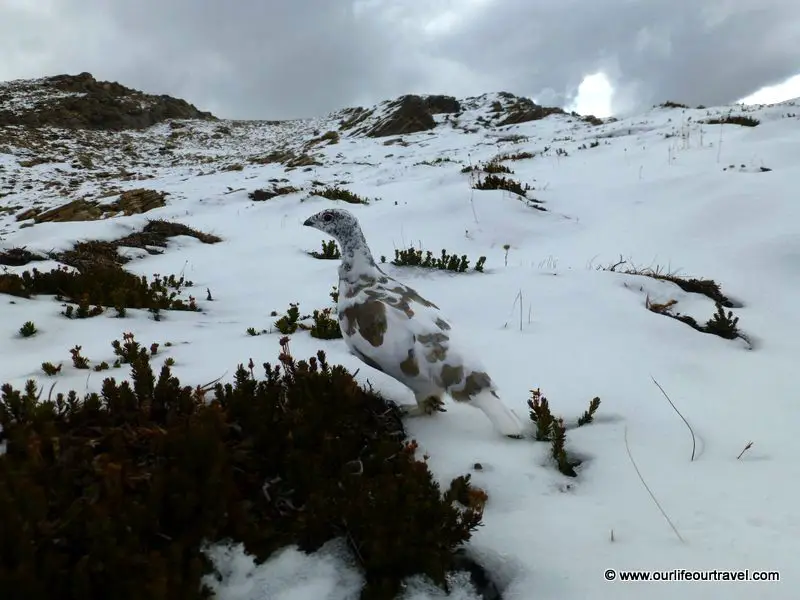
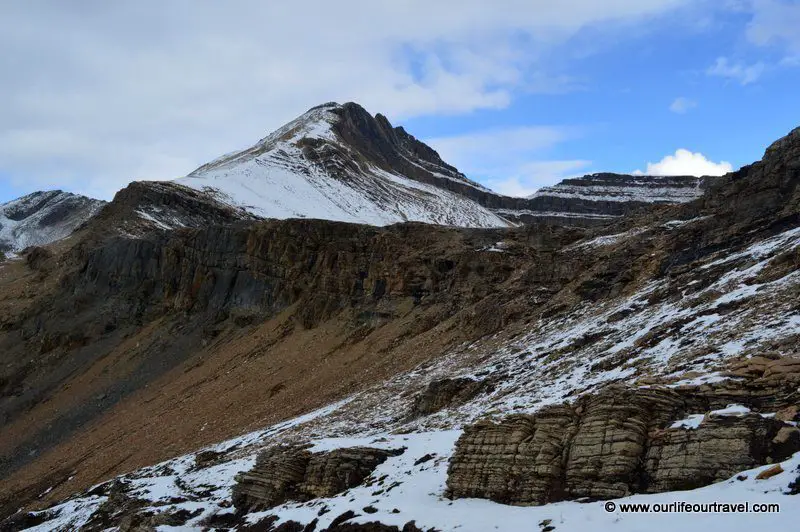
Day 6. Banff – Columbia Icefield – Banff (350 km) + hike to Parker Ridge
What to do on a snowy day? Check out more glaciers! We decided to drive a bit more because the weather was supposed to get better there and check out Athabasca and Saskatchewan, just to name two glaciers from the Columbia Icefield. On a road trip through the Canadian Rockies, you never can be sure about the weather conditions.
Athabasca Glacier is the location of a significant tourism business. If you pay, you are taken up by a bus near the foot of the glacier. It is probably possible to take some fantastic shots from there. As it was not our first or last glacier, we didn’t even consider paying for it. We just had a walk from the parking place up to the river, formed from the melting ice.
The biggest attraction was not even the ice cave entrance we could see, but our first ever seen avalanche. An enormous amount of snow ran off from the top of one of the side glaciers to the central valley. It started small, and at first, we thought it is a waterfall, but soon we realized it isn’t. Luckily (or unfortunately?), we were very far from it, but we could take few pics of the happenings, although not initially.
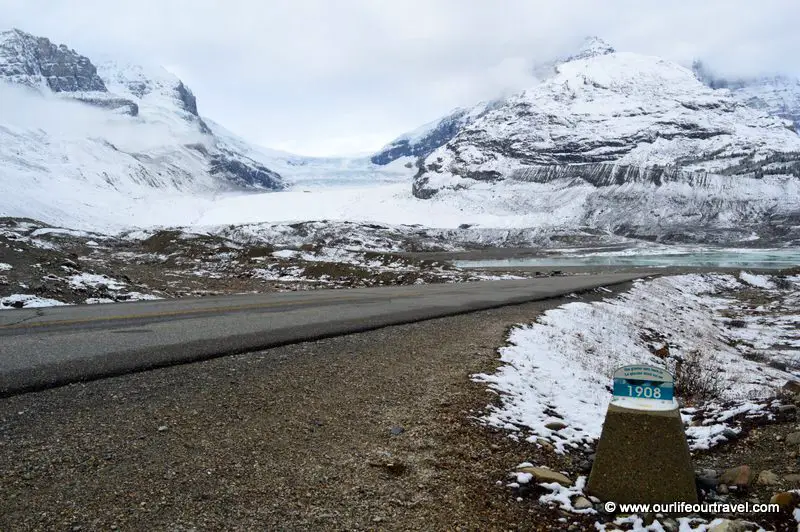
| Parker Ridge Hike |
|---|
| Distance: 6 km |
| Elevation Gain: 250 m |
| Number of people we met:20+ |
[sgpx gpx=”/wp-content/uploads/gpx/parkerridge.gpx”]
The weather was still very cloudy, but we decided to hike up to Parker Ridge (6 km, 250 m elevation gain) to check out another glacier: Saskatchewan. Unfortunately, we could only see the upper part of it behind the clouds and some km in the valley where it is already melted, and just the debris left. We haven’t seen the edge.
On our drive back to Banff, the clouds were much higher than in the morning to enjoy a bit more views.
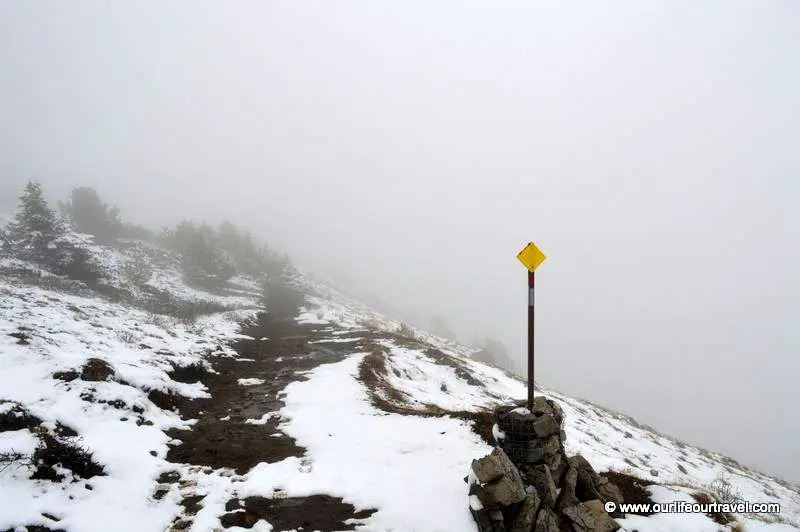
Day 7. Banff – hiking the Cory Pass loop
| Cory Pass Hike |
|---|
| Distance: 15 km |
| Elevation Gain: 1150 m |
| Number of people we met: 4 |
[sgpx gpx=”/wp-content/uploads/gpx/corypass.gpx”]
Another cloudy day. With only a few minutes of driving, we reached the parking lot near Bow River. Today’s goal was to reach the Cory Pass. During the first few kilometers, we had a lovely view of the Bow River, Trans-Canada Highway, railway, and Banff while ascending. The route later zigzags up on the edge of the forest, and in clear weather, you can see the mountain tops as well, but we only saw the valleys and not even the bottoms of them.
Before the Cory Pass, we walked on a very narrow one-person-wide trail, which has steep downhill on our left. That was the point where the trees had excellent snow cover. It looked lovely, but I still think it was the least spectacular hike among all we did during the last days. First, we passed two junctions with trails that head up to Mount Edith. Then we finally reached the Cory Pass, which was above the clouds! Amazing pictures time! Two other guys had similar ideas and took photos of the peaks showing up from the clouds.
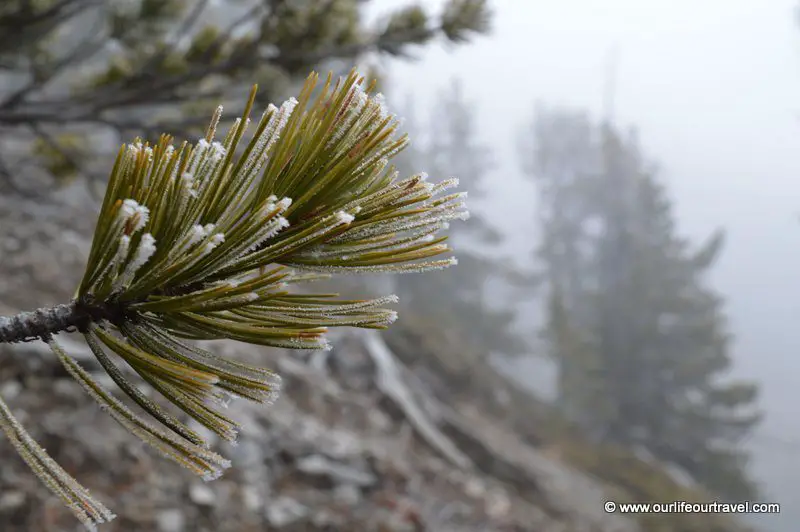
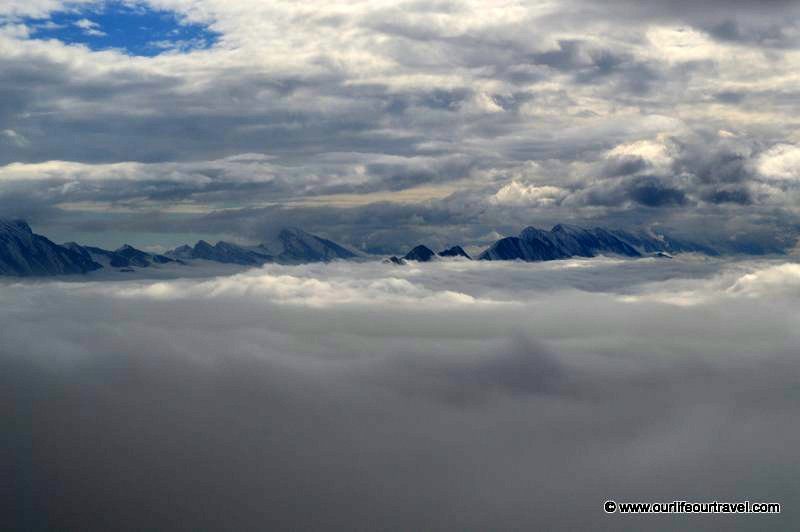
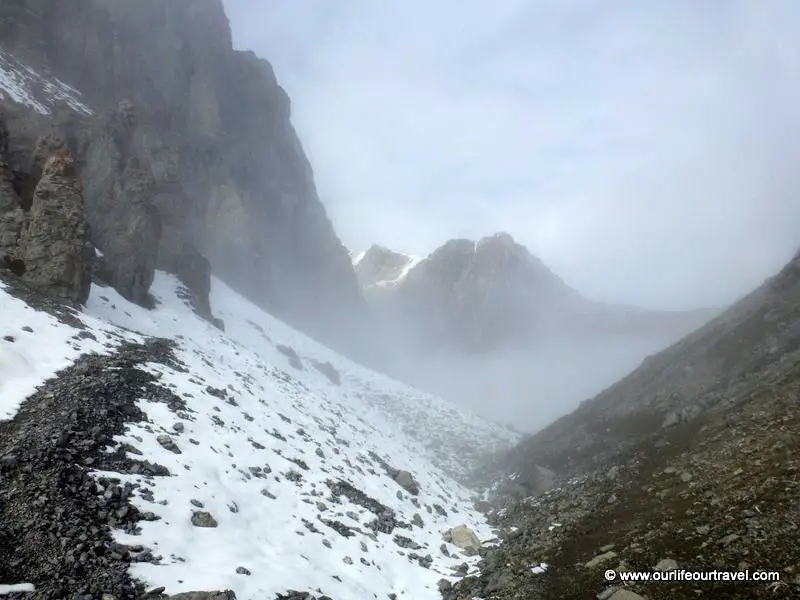
After admiring the view, we continued on the trail down from the pass on the other side. It was very snowy and a bit slippery. In Gargoyles Valley, Stone pillars surrounded the route, but we could only see the closer ones because of the valley’s cloud. We could hear stones and rocks moving and falling. Karol even spotted one flying above me. I got a bit scared, and we sped up.
After a kilometer, we reached a part with big rocks. We followed the footprints in the snow, but we realized they lead in the wrong direction, so after this short detour and about an extra 100 m elevation loss and gain, we found the correct way to Edith Pass. The rest of the trail was rather flat, slowly descending. There were a lot of fallen trees out of the trail. The last kilometers were in the forest without any views. The loop took us about 7 hours and was much more spectacular than I expected. I fell in love with the mountains every day.
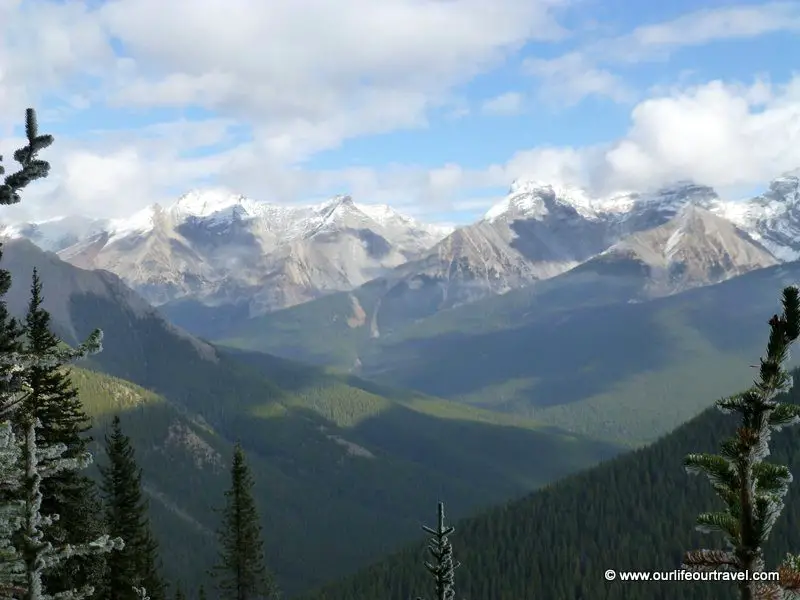
Day 8. Banff – surrounding of Lake Louise – Banff (140 km driving + short walks)
We woke up to snow. A couple of centimeters covered the trees, the roofs, and cars, even in Banff. And it was still falling, reducing the visibility close to zero. The mountains disappeared behind the snow clouds. It was a perfect time to do some lazy, low-altitude walk around a few lakes.
| Moraine Lake Walk |
|---|
| Distance: 1-2 km |
| Elevation Gain: 20 m |
| Number of people we met: 100+ |
